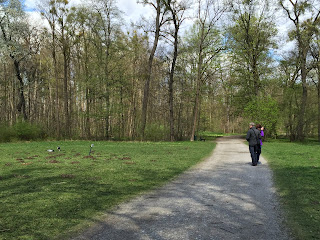18 April 2015 (Saturday) - Schloss Nymphenburg Palace Grounds. I'm back in Singapore, but playing catch up with postings of my visits in the past three months. During this Europe trip, my favourite place is undoubtedly the Nymphenburg Palace. Hence here's a special post dedicated to the huge palace grounds of Nymphenburg.
The Badenburg was built during the reign of Elector Max Emanuel. He had the rooms decorated in the Chinese fashion, a style new to Bavaria at the time. Imported silks, lacquerware and porcelain from East Asia, much coveted in northwestern Europe since around 1680 were integrated into Indian style interiors.
Don't you love the rose pink wallpaper with the green peacock motifs?
The wall covering in the bedroom shows a high imperial official with his mistress, members of his family and the servants. Rising up in the background is a panorama-like landscape showing evidence o the beginnings of a linear perspective, a stylistic concession to European visual tastes.
The ceiling decoration of the writing room lends a playful, ironic touch to the room. Scenes depicting monkeys, a popular motif at the time, form part of the exotic overall iconography. By mimicking human beings, the monkeys hold up a mirror to our sins and foolish ways...
A palette of silver, white and yellow was used in this masterpiece of interior design from the period of Max Emanuel. I really love this colour combination!
The Grand Cascade was a project by Elector Max Emanuel's architect, Joseph Effner. He was also responsible for the building of Badenburg, Pagodenburg and the Magdalenenklause.
In the small hall on the ground floor, which is lined with Dutch tiles and the rooms on the upper floor with their lacquering and Chinese wall coverings, an exotic Chinese atmosphere was been created. The Pagodenburg is another excellent example of the Chinese style that was popular in early 18th century Europe.
The Magdalenenklause was built from 1725 to 1728 and is one of the earliest examples in Europe of a park building consciously designed as a ruin.
Built in the Italian style in imitation of a hermitage, it contains a chapel designed to resemble a grotto and the electoral apartment with rooms of monastic simplicity. The hermitage was intended as a place for religious contemplation of the transitoriness of earthly lives.
And of course how can I miss the lovely swans? This one swam up to the bay and was posing in all angles for my photos like Munich's Next Top Model!
Thanks for all the wonderful memories Schloss Nymphenburg!































































